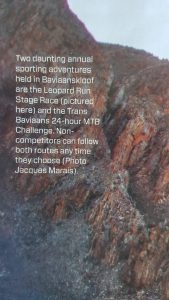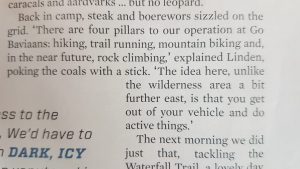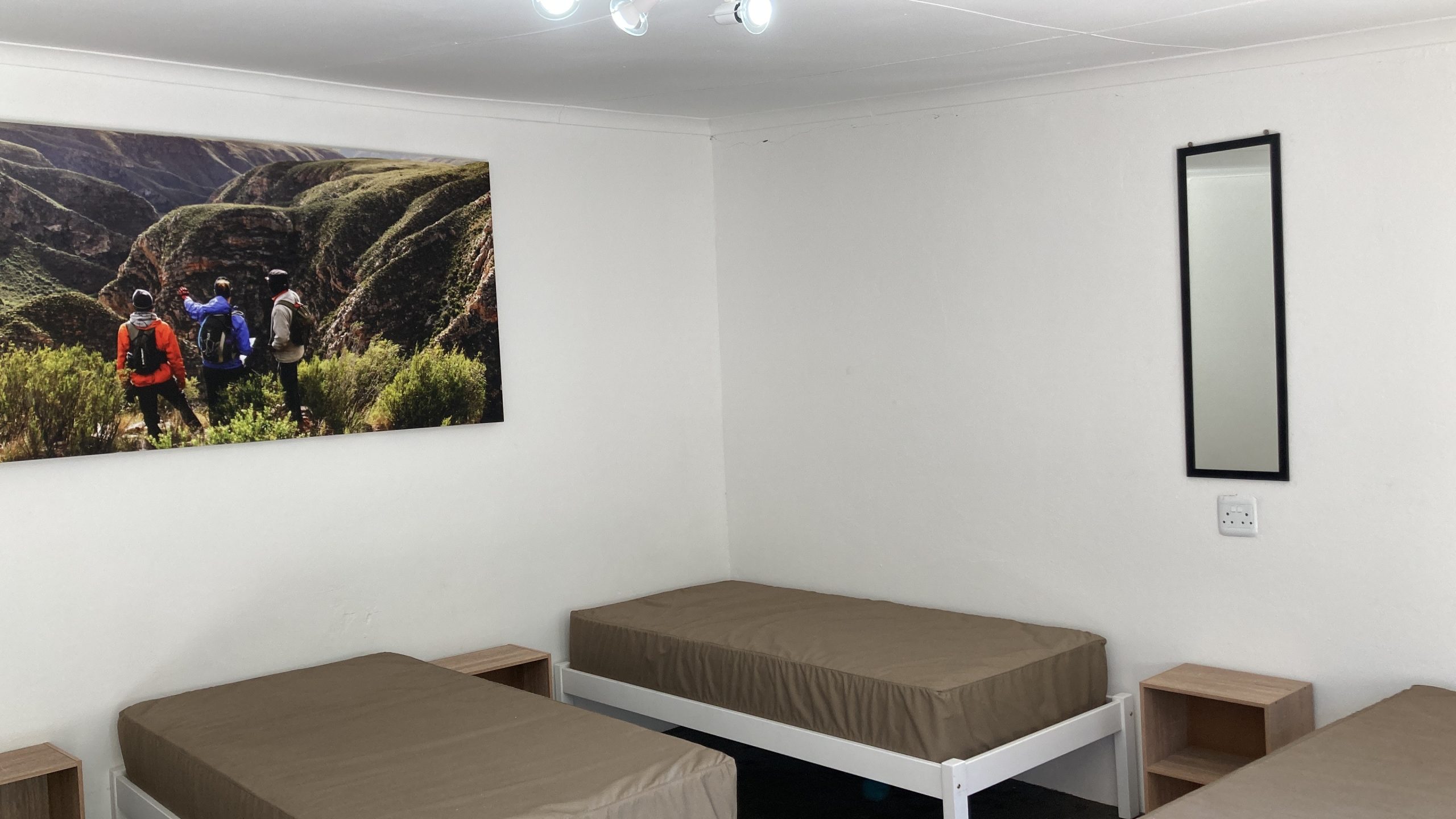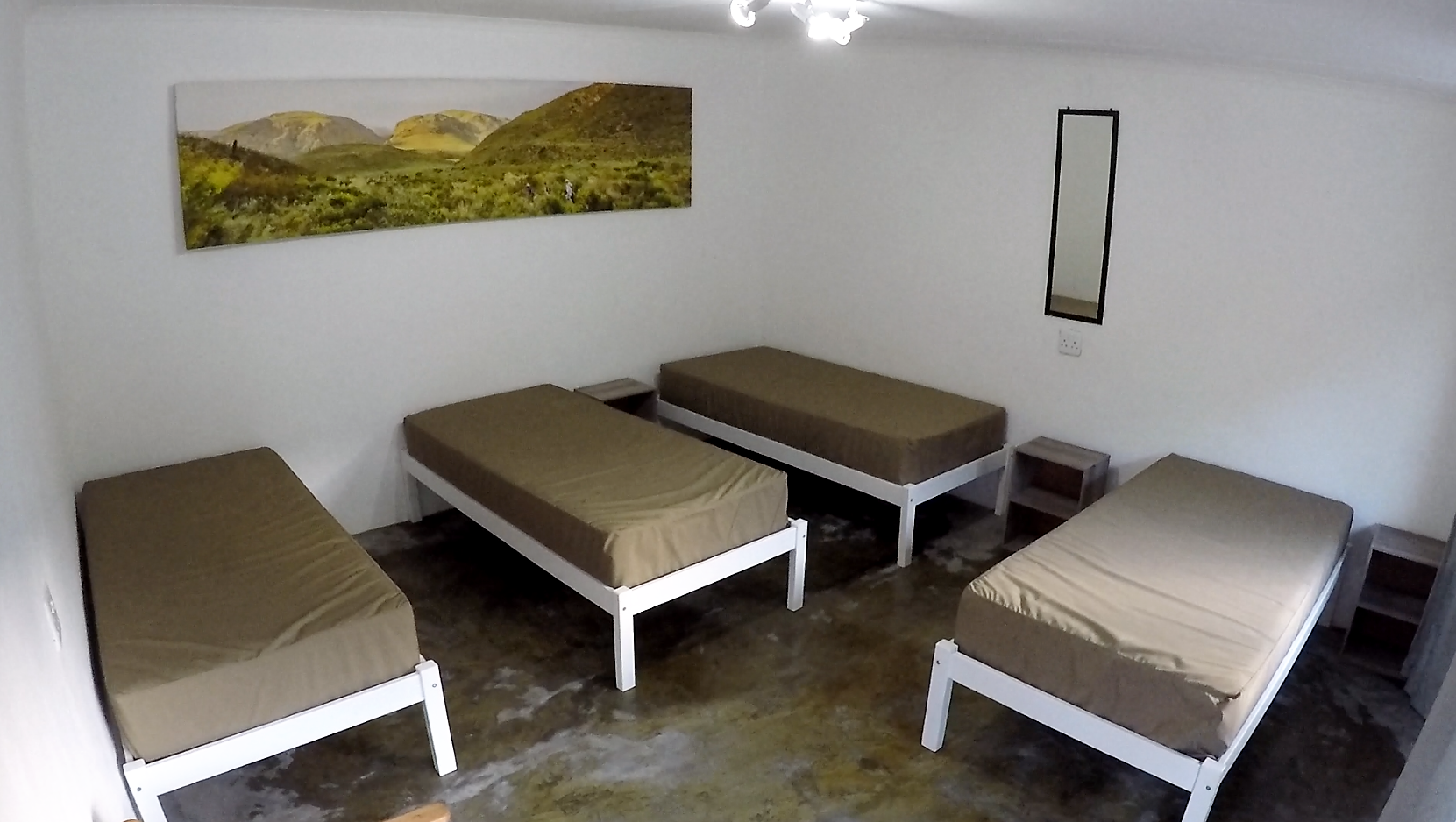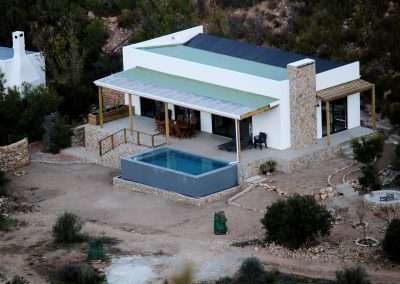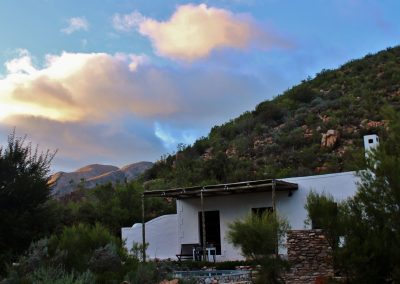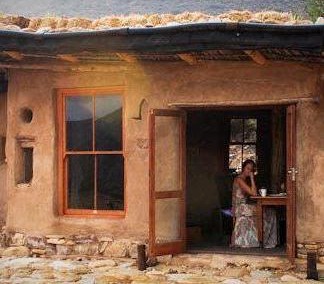Backpackers
Self catering Backpackers, R600 per room per night, bedding and towels not provided.
Situated at reception area where the Leopard trail starts and finishes, this is the perfect base to book for the night before and the night after you hike. The Backpackers consists of three separate rooms each with their own entrance. Each room has 4 single beds, solar power for lights and charging electronic devices, and a safe for valuables.
There is one communal bathroom with toilets and hot gas showers. There is a large, well equipped shared kitchen with gas fridge/freezer, gas stove top, hot running water and wash facilities. Connected to the kitchen is a covered veranda with a portable braai as well as a fire pit.
The rate is R600 per room per night – please bring your own sleeping bags, bedding and towels.
You can find relief on hot days in the large cement reservoir swimming pool that is available to all guests at Cedar Falls, fed by clear, fresh water from the mountain stream.
Please note that as we are in a World Heritage Site, we are unable to accommodate pets.
Check in is anytime from 3pm onwards, and check out by 9am. Guests are welcome to arrive earlier and leave later if you want to do walks, however please ensure you are out of your accommodation so that our team can start cleaning for the next guests.
Other Accommodation Options at Cedar Falls
Visitors Book
Leopard Trail Booking Policy 2026
Bookings for the Leopard Trail for hikes in 2026 onward will be made per sleeping hut, not per person. Each sleeping hut sleeps 4 people, and there are 3 sleeping huts in total. To secure a start date, a minimum of 2 sleeping huts will need to be booked. If you only book 2 sleeping huts (instead of all 3), you’ll have a 2-month window to add the 3rd sleeping hut to your booking. After that, the unreserved hut will be made available to other hikers. The single communal cooking hut is for all 12 people, and is shared by people staying in the 3 sleeping huts.
(Bookings for January to March 2026 will open on the 3 February 9am)
WHY THIS CHANGE?
With the leopard trail fully booked out a year in advance, we aim to make sure we are giving as many people as possible a chance to hike the trail. In the past we kept each group exclusive – once you booked the minimum number of 8 hikers, we did not open that booking date up to other hikers. This meant we often had a hike starting with fewer than 12 hikers.
We value giving hikers the opportunity to have an exclusive group of friends and family. However, if the group cannot fill the 12 spots, we need to be able to open it up to other people. We have been talking to our hikers to get feedback and ideas on how to solve this problem. A key piece of feedback is that while hikers are happy to, and often enjoy, sharing the hike and communal hut with people not part of their own hiking group, they would strongly prefer to control who is sharing their sleeping hut of 4 people with them. In this scenario it makes more sense to treat each sleeping hut as the booking units, rather than per person.
BENEFITS AND CONSIDERATION
The upside of the new policy is that it allows a group to work towards an exclusive group of 12 people, sharing the 3 sleeping huts, while ensuring hiking spaces do not go to waste.
It keeps the minimum for the first group booking to 8, rather than increasing it higher. The potential challenge is that it requires hikers to book per hut in increments of 4 people – 4, 8 or 12 hikers.
Like every aspect of the Leopard Trail, we are very interested in, and receptive to, feedback. We’ll trial this system for bookings between January and March 2026 and welcome your feedback to ensure it’s clear, fair, and user-friendly.
PRACTICAL EXAMPLES
- A group wants to book a starting date for 12 people. In this scenario the group will book and pay for all 3 sleeping huts. No other hikers will be able to book for that date.
- A smaller group of people, less than 12 people, want to have complete exclusivity. In this scenario they will book all 3 huts. Even if there are not 12 people, they will still pay the full price for the 3 huts. To keep the per person cost to a minimum, they would strive to find additional people to meet the maximum of 12 hikers.
- A group wants to book a starting date. They have 8 people confirmed and keen. In this scenario the group will book and pay for 2 sleeping huts. If they do not increase the booking to include the 3rd hut after two months, the 3rd sleeping hut will be opened for an additional group of hikers to book.
- A group wants to book a starting date. They have 5 people confirmed and keen. In this scenario the group will need to book and pay for 2 sleeping huts. To keep the per person cost of the hike to a minimum, they will try and get to the 8 people that can sleep in those 2 huts. Even if there are only 5 people, they will still pay the full price for the two sleeping huts. If they do not take up the option of the 3rd sleeping hut after 2 months, the 3rd sleeping hut will be opened for an additional new group of up to four people to book.
- A group of four or less wants to book a single sleeping hut but do not want to book the minimum of 2 sleeping huts to secure their preferred starting dates when bookings open. In this scenario the group will not be able to book immediately when the booking dates open. They will need to wait for 2 months to pass from the date the bookings for that time period opens. After 2 months, those dates that have not had all three sleeping huts booked by a single group will be opened for a group of up to 4 people to book the remaining sleeping hut. They can choose from the dates that may be available.
- Two people want to book a hut just for themselves. In this scenario they can either be part of a larger group that books 2 or 3 sleeping huts and pay for a sleeping hut just for themselves. Alternatively, they can wait for extra huts to be released after the 2-month period. In either case they will pay the full price for the hut, even though there are just 2 people. The preference is that they opt to have a full hut of four people, as we are trying to create as many spaces for hikers to do the leopard trail as possible.
How to get the dates you want for the Leopard Trail
The Leopard Trail is often booked out within hours of us opening bookings, and so we thought we would share some notes on how to book in a way that increases your chances of getting the dates you want.
- Firstly, we do not give anyone early access or preferential bookings. When we open the bookings to the public, everyone has the same chance to get a booking. The only dates that may not be available are for our own team’s inspection hikes (usually one booking every quarter).
- All bookings must be made through our website.
- We usually open up bookings for three months at a time. The date and time the bookings will open will be publicized on our social media pages.
- You will need to make a minimum booking for at least 6 people, up to a maximum of 12 people. You can add more people at a later stage if required if you do not take all 12 spots immediately.
- When making a booking, select only the starting date of your hike.
- We use a third-party booking system that follows the same principles as most booking and ticketing services. There are a few things worth noting:
- The booking system only blocks out a booking as being not available when someone making that booking has completed the booking process.
- Therefore if you and another person both start booking a specific date at the same time, the first person to complete the booking will receive the date, while the second person will be told the date is no longer available even if they are in the process of finalising the booking.
- Given the above, your goal should be to complete your booking as quickly as possible. The main option to speed up this process is to select paying by EFT, rather than credit card, at the time you are making your booking, as taking time to enter credit card details and complete the payment will take longer to finalise the booking
Leopard Camera Project
We are getting trail camera’s back on the Leopard Trail – and YOU can be a part of the volunteer team.
At various times in the history of the Leopard Trail we have had game cameras in the mountains, and it is time to get camera’s back on the trail. Game camera’s help us to have a clear understanding of the wild animals walking the Leopard Trail, and let us share that information with hikers on the trail. The information is also very valuable for our partners the Eastern Cape Parks and Tourism Agency.
Project Outline
This project is driven by volunteers who share our passion for the area. We will be placing between 6-8 trail camera’s on the Leopard Trail at various points, with the aim to keep the camera’s operation for a full calendar year. These camera’s need to be visited every 2 months to replace batteries and download images.
Project Phases
First Phase: Technical planning.
This first phase involves the necessary research into trail cameras, identifying the best camera’s for our purpose and researching the best practice for setting the cameras. Our experience over the years has given us a lot of knowledge, and we update this by exploring new developments in camera technology as well as talking to other organisations that have current experience in using trail cameras.
Second Phase: Camera Installation
Over a few days, the camera’s will be installed on site and tested. The placement of the camera’s will focus on key points on the trail with natural funnels that channel animals onto the path.
Third Phase: Camera Monitoring
Every 2 months the cameras will need to be visited to change the batteries and upload the images. This will likely require 2 -4 days of walking to the various camera sites. The volunteer team will be based at Cedar Falls base camp, and visit the camera sites with 4×4 vehicles as far as possible and then walking in to the sites. The images downloaded will then be uploaded to a central data point for distribution to the Leopard Trail team and any of our conservation partners.
Project Operations
The project is run through a team of non-paid volunteers from the Leopard Trail hiking community. The purpose of using volunteers is to broaden the exposure our hiking community has to being a part of the Leopard Trail, and create opportunities for people with an interest and passion in the Leopard Trail environment to be part of our broader Leopard Trail team.
Volunteers will not be required to do all the trips and may only be involved in one or two of the trips based on how many volunteers are involved in the project.
The Leopard Trail will cover all the costs of the camera’s and equipmen. Accommodation will be provided to volunteers by Cedar Falls for the time that volunteers are on site working on the project.
Time Line
June – July Technical Phase
September – Camera Installations
November – First Camera Monitoring
January – Second Camera Monitoring
March – Third Camera Monitoring
May – Fourth Camera Monitoring
July – Fifth Camera Monitoring
September – Sixth Camera Monitoring
Want to be a part of the project?
If you would like to be a on the volunteer team for the project, sign up here. If you have any questions, please go to our Leopard Trail Hikers Community Page and drop us a question in the post talking about this project.
A shout out to our partners at the ECPTA
10 years ago the idea of the Leopard Trail was born around a camp fire by the team at Cedar Falls. Those sitting there were dwarfed by the night sky and the silhouette of the magnificent mountains of the Baviaans World Heritage Site Reserve – a call to create something special. The next day we worked through the plan of how it could work, what would be required and how to set it up as a community project. We had one problem though – we needed some mountains to walk through.
The best routes would take us into the reserve, and for that we would need the Eastern Cape Parks and Tourism Agency (ECPTA) to agree to the project and give us permission to send hikers into the great Baviaans mountains. We were confident that given the incredible potential of the project to combine community development, conservation and the promotion of a green economy, we could get the ECPTA onboard.
And indeed, over the next few months the ECPTA became an enthusiastic partner, supporting the idea wholeheartedly. While they did not have resources to help get the project started, the ECPTA team created the enabling environment and permissions for the project to keep moving, while also committing to see if they could help in the raising of funds for the eventual building of huts that would open the project to a wider audience of hikers.
It took us a good few years to get the hike to a point where we could get the first feet on the trail. Our community project finally received the Environmental Impact Approval we needed, and was able to borrow money to get a team of locals into the mountains for 8 months to create the trail and buy a 19 year old Land Cruiser to transfer hikers bags from night to night. During this time we were always hopeful that somehow we would find funds to eventually build huts for hikers, though for the time being the trail started with a tented camp option.
Five or six years into the project we received an unexpected and surprising call from the ECPTA. Through a partnership with the National Department of Tourism they had been able to secure funds for the building of huts on the trail! The actual construction of huts would not start for another two years, but for all of us involved we felt massive relief and excitement that huts would be coming.
The huts are now complete and are superb! The Leopard Trail is consistently included in most bucket lists of must do hikes in SA, and with the addition of the huts it is becoming vital for hikers to book way in advance to secure a spot. Through the partnership between the Leopard Trail and the ECPTA, the idea that was born 10 years ago has grown into a project that is far more than just a hike. It is a stunning example of how great partnerships can change lives.
So from the team that sat around that camp fire 10 years ago and all the people on the ground who are involved in the bigger project, we would like to say a heart felt thank you to all of our partners at the ECPTA. Here’s to a long future of creating a legacy for hikers and locals alike.
New video of trail running on the Leopard Trail
Getaway Magazine visits the Leopard Trail
It is always great when the the top magazines call and ask to pay us a visit. Not only is it good exposure for our project, but most of the time it is good solid outdoorsy type people. Justin was a good example, willing to traipse along as we checked cameras and hiked to the Cedar Falls. What we appreciate most about this write up is that he gets our mission – to provide the base camp from which people can explore the true magnificence of the Baviaanskloof from OUTSIDE of their vehicle. Most people visiting the area stay firmly inside their 4×4’s. The true magic however is what you find when you go for a hike, jump on your MTB or get your trail running shoes on.
